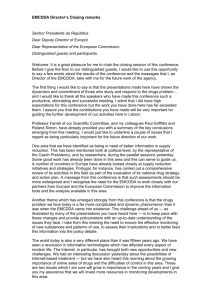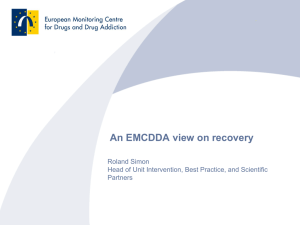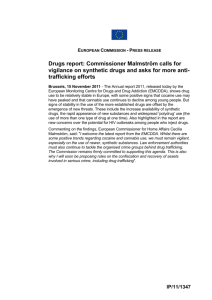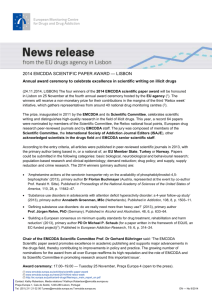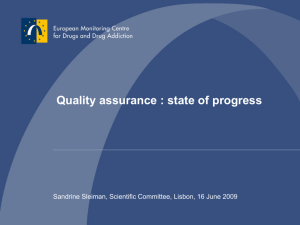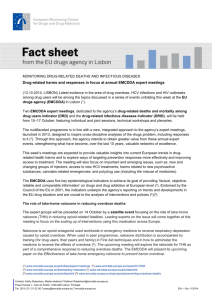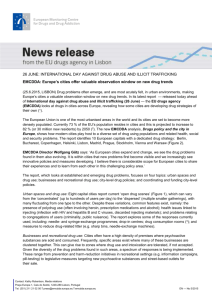Evaluation of the EU strategy and action Plan on drugs
advertisement
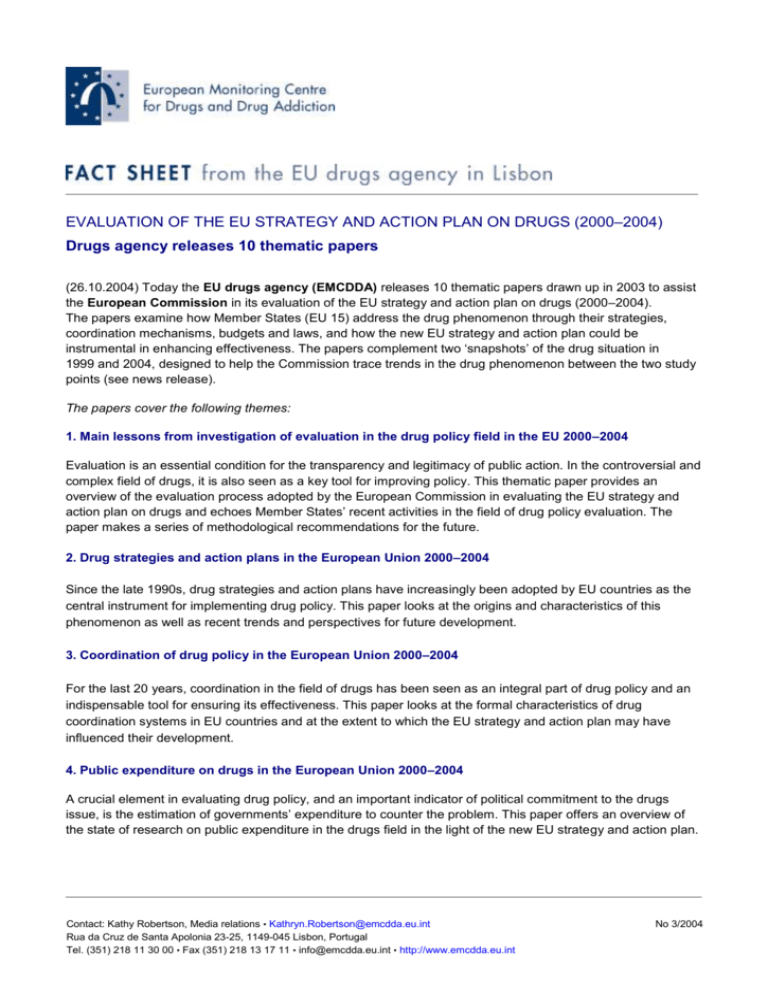
EVALUATION OF THE EU STRATEGY AND ACTION PLAN ON DRUGS (2000–2004) Drugs agency releases 10 thematic papers (26.10.2004) Today the EU drugs agency (EMCDDA) releases 10 thematic papers drawn up in 2003 to assist the European Commission in its evaluation of the EU strategy and action plan on drugs (2000–2004). The papers examine how Member States (EU 15) address the drug phenomenon through their strategies, coordination mechanisms, budgets and laws, and how the new EU strategy and action plan could be instrumental in enhancing effectiveness. The papers complement two ‘snapshots’ of the drug situation in 1999 and 2004, designed to help the Commission trace trends in the drug phenomenon between the two study points (see news release). The papers cover the following themes: 1. Main lessons from investigation of evaluation in the drug policy field in the EU 2000–2004 Evaluation is an essential condition for the transparency and legitimacy of public action. In the controversial and complex field of drugs, it is also seen as a key tool for improving policy. This thematic paper provides an overview of the evaluation process adopted by the European Commission in evaluating the EU strategy and action plan on drugs and echoes Member States’ recent activities in the field of drug policy evaluation. The paper makes a series of methodological recommendations for the future. 2. Drug strategies and action plans in the European Union 2000–2004 Since the late 1990s, drug strategies and action plans have increasingly been adopted by EU countries as the central instrument for implementing drug policy. This paper looks at the origins and characteristics of this phenomenon as well as recent trends and perspectives for future development. 3. Coordination of drug policy in the European Union 2000–2004 For the last 20 years, coordination in the field of drugs has been seen as an integral part of drug policy and an indispensable tool for ensuring its effectiveness. This paper looks at the formal characteristics of drug coordination systems in EU countries and at the extent to which the EU strategy and action plan may have influenced their development. 4. Public expenditure on drugs in the European Union 2000–2004 A crucial element in evaluating drug policy, and an important indicator of political commitment to the drugs issue, is the estimation of governments’ expenditure to counter the problem. This paper offers an overview of the state of research on public expenditure in the drugs field in the light of the new EU strategy and action plan. Contact: Kathy Robertson, Media relations • Kathryn.Robertson@emcdda.eu.int Rua da Cruz de Santa Apolonia 23-25, 1149-045 Lisbon, Portugal Tel. (351) 218 11 30 00 • Fax (351) 218 13 17 11 • info@emcdda.eu.int • http://www.emcdda.eu.int No 3/2004 Evaluation of the EU strategy and action plan on drugs (2000–2004) 26.10.2004 5. Legislative activity in the period 2000–2004 This paper looks at the extent to which legislative attention was paid in the period 2000–2004 to actions considered by Member States to be of high priority at the outset of the strategy and action plan. Over 250 legal texts are analysed and compared with actions specified in the plan. 6. Drug law and young people 2000–2004 One of the targets of the EU action plan is ‘to reduce significantly over five years the prevalence of drug use, as well as new recruitment to it, particularly among young people under 18 years of age’. This paper identifies the legal activity undertaken by EU countries between 1999 and 2004 and how it might be attributed to, or have been made in the spirit of, references to young people in the plan. 7. Drug-using offenders in the European Union 2000–2004 Drug use is directly or indirectly prohibited in all EU countries, except for in medical or scientific circumstances. Punishment for offences varies from administrative to penal, depending on the country. This thematic paper analyses current trends in the EU Member States in responses targeting drug-using offenders. 8. Legal responses to new synthetic drugs 2000–2004 This paper highlights evidence of legislative activity related to new synthetic drugs as an indicator of Member States’ commitment to the issue. It also examines to what extent legal activity in this area may be attributed to the EU action plan on drugs. 9. Evolution of EU budget-lines on drugs 2000–2004 Although the EU action plan on drugs foresees a series of activities for the period 2000–2004, and although the EU strategy calls for the provision of appropriate resources for drug-related actions and social consequences of drug use, no specific budget is allocated to the execution of the plan. Instead the plan relies on funds allocated to various Community initiatives and programmes covering the drug problem. This paper studies the evolution of EU drug budget-lines adopted between 2000 and 2004 as a measure of commitment to the drug phenomenon. 10. Drug provisions in the EC external agreements 2000–2004 Cooperation on drugs with countries outside the EU is a specific objective of the EU strategy and action plan. This paper looks at the extent to which provisions on drugs were included in the European Community’s external agreements in the period 2000–2004 and examines their content and funding. Full texts and summaries of the 10 EMCDDA Thematic papers are available today at: http://snapshot.emcdda.eu.int Notes (1) The ‘Communication from the Commission to the Council and the European Parliament on the results of the final evaluation of the EU drugs strategy and action plan on drugs (2000–2004)’ is presented this week by the European Commission at the Justice and Home Affairs Council meeting in Luxembourg. The full Communication is available at http://europa.eu.int (2) A news release on the Snapshot exercise is released today at: http://www.emcdda.eu.int/?nnodeid=875 The Snapshot report is available at http://snapshot.emcdda.eu.int EMCDDA Thematic papers 2
